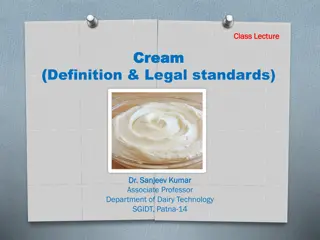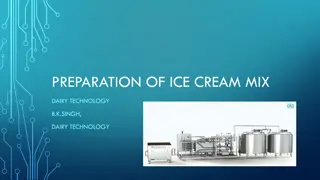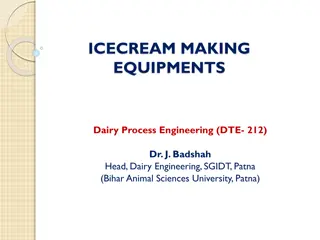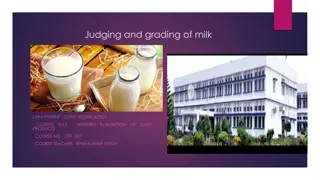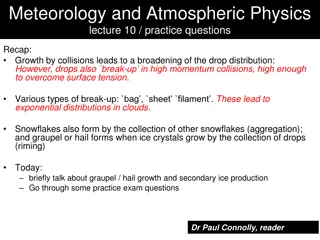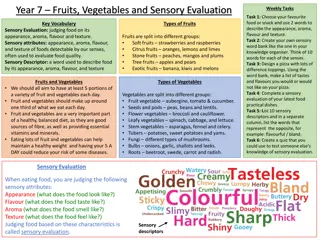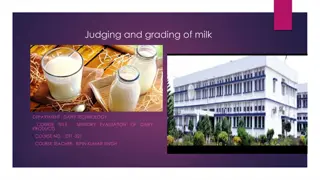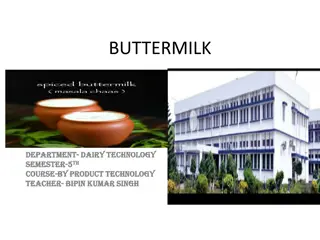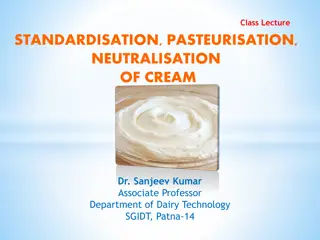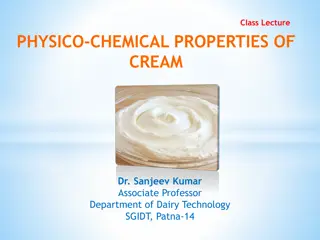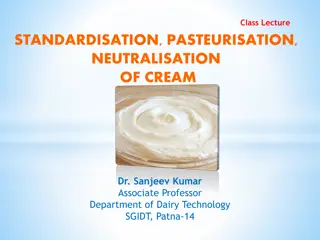Understanding Sensory Attributes of Ice Cream and Frozen Desserts in Dairy Technology
Ice cream and frozen desserts are formulated with dairy products, sugars, flavorings, and stabilizers. Various types are available, each with unique characteristics like flavor, body, texture, and melting quality. High-quality ice cream should possess a balanced flavor, desirable body, and smooth melting properties. Learn about the essential sensory attributes for evaluating ice cream quality.
Download Presentation

Please find below an Image/Link to download the presentation.
The content on the website is provided AS IS for your information and personal use only. It may not be sold, licensed, or shared on other websites without obtaining consent from the author. Download presentation by click this link. If you encounter any issues during the download, it is possible that the publisher has removed the file from their server.
E N D
Presentation Transcript
SENSORY ATTRIBUTES OF ICE CREAM AND FROZEN DESSERTS DEPARTMENT : DAIRY TECHNOLOGY COURSE TITLE : ICE CREAM & FROZEN DESSERTS COURSE NO. : DTT -222 COURSE TEACHER: BIPIN KUMAR SINGH
Introduction Ice cream is a frozen food made of a mixture of dairy products, such as milk, cream, and nonfat milk, combined with sugars, flavoring, fruits and nuts, stabilizers and emulsifiers etc. Different types of ice cream are available in the market including economy, premium, super-premium reduced fat, light, low fat ice cream, mellorine, depending on their composition, soft serve ice cream, sherbets, ice candy and kulfi. All the above products may differ in the type of flavoring, the composition in terms of dairy ingredients and other food solids, and the extent of product overrun. Ice cream is normally judged on the basis of its flavour, body and texture, colour and package and melting. The ideal characteristics of ice cream and requirements for high quality ice cream and frozen desserts are described in this lecture.
Flavor High-quality vanilla ice cream should be pleasantly sweet, suggest a creamy background sensation, exhibit a delicate bouquet of vanilla flavor, and leave a most pleasant, but brief, rich aftertaste. The flavor intensity of the vanilla, the sweetener, and the various dairy ingredients should not be so pronounced that, when first tasted, one component of the overall flavor seems to predominate over the others. All of the ingredients should blend to yield a pleasant, balanced flavor.
Body and Texture Body and texture are important properties of ice cream and good quality indicators. The associated body and texture defects are evaluated by biting and chewing the product. As it relates to ice cream, body is best defined as the property or quality of the ice cream as a whole. Texture refers to the parts or structure of ice cream that make up the whole. Both the body and texture of ice cream may be partially determined by applying the senses of touch and sight when the evaluator observes the product s appearance on dipping. The desired body in ice cream is that which is firm, has substance (has some resistance), responds rapidly to dipping, and is not unduly cold when placed into the mouth. The melted ice cream should resemble the consistency of 40% fat cream.
Melting Quality Good quality ice cream should show little resistance towards melting when a dish is exposed to room temperature. During melting, the mix should drain away as rapidly as it melts and form a smooth, uniform and homogenous liquid in the dish. Any variation from this behaviour is due to some defect and leads the consumers to be suspicious of its quality. Though the weightage to the melting quality is low (5 points), it is an important attribute on account of its correlation with the body and texture.High-quality ice cream should show little resistance toward melting when a dish is exposed to room temperature for at least 10 15 min. During the melting phase, the mix should flow from the center (high) portion of the scooped ice cream. The melted product should be expected to form a smooth, uniform, and homogeneous liquid in the dish. Generally, ice creams with low overrun melt more rapidly than those with high overrun.
Color and Package Color:The colour should be attractive, uniform, pleasing and typical of the flavour present in ice cream. Vanilla ice cream is invariably plain (no colour).The colour defects of ice cream are grey/dull; non-uniform, vivid and unnatural.Colorants may or may not be added to dairy frozen desserts. As long as the shade of color reasonably resembles the natural color ( -carotene pigment) of cream and is neither too pale nor too vivid, color criticisms are generally resisted for vanilla-flavored products Package:The package or container should be neat, clean, attractive, full and protective. The common package defects are: soiled, rusty, damaged, shrunken ice cream, ill shaped, etc. Multiuse containers (if used) should be free of dents, rust, paint, battered edges, or rough, irregular surfaces. In general, ice cream packages should reflect neatness and cleanliness throughout, giving the consumer the impression that by use of a clean, well-formed container, the manufacturer is definitely interested in supplying a high-quality product.
Other Frozen Dairy Desserts Low fat ice cream Mellorine Fruit Frozen Desserts Nut Frozen Desserts Variegated Frozen Desserts Soft-Serve Frozen Desserts Frozen Novelties
Ice Cream Scorecard S.No 1 2 3 4 Characteristics Flavour Body & Texture Bacteria Colour & Package Max. Score 45 30 15 5 Sample Score 5 Melting Quality 5
Scoring Technique of Ice Cream Tempering of ice cream:temperature in range of 15oC to 12.2oC is satisfactory for tempering the ice cream for sensory evaluation. To achieve, this ice cream should be taken out from the hardening room and placed in dispensing cabinet several hours prior to judging. In this way, ice cream tempers uniformly. Sampling:The retail package of ice cream should be served as such for judging.In case of a large lot or bulk, a regular ice cream dipper or scoop is used for drawing the sample.
Scoring Technique of Ice Cream The condition of ice cream starts changing immediately after taking it out of the cold store. Therefore, the judging and scoring of ice cream should be very fast. The judges should record their observations as quickly as possible, particularly about the body and texture characteristics. The observations should be made in the following sequence: Examine the container cleanliness, fullness, printing defects, etc. a. Note the color of ice cream for its intensity and uniformity. b. Note the product cuts and feel of the dipper as its cutting edges pass through the frozen mass. c. Before melting of ice cream, texture characteristics, such as gumminess, grittiness, coarseness, sandiness, etc. should also be felt simultaneously. d. Note the melting quality of ice cream. whether the melted liquid is creamy curdled, foamy, watery, and whether the tiny channels are formed as the melt drain flow down the sides of mass. e.
Undesirable Attributes of Ice Cream Melting quality: Does not melt or delayed melting, flaky or scummy, foamy or frothy, wheying off or curdled and watery. Body and texture: Crumbly (brittle/flaky/snowy), gummy (pasty/sticky), shrunken, soggy (heavy/doughy), weak, buttery/greasy, coarse (grainy/ icy/spiny), fluffy and sandy. Off flavours: Cooked, sour, old ingredients, rancid, salty, inadequate or excessive flavour, oxidized/tallowy, neutralizer, etc.



